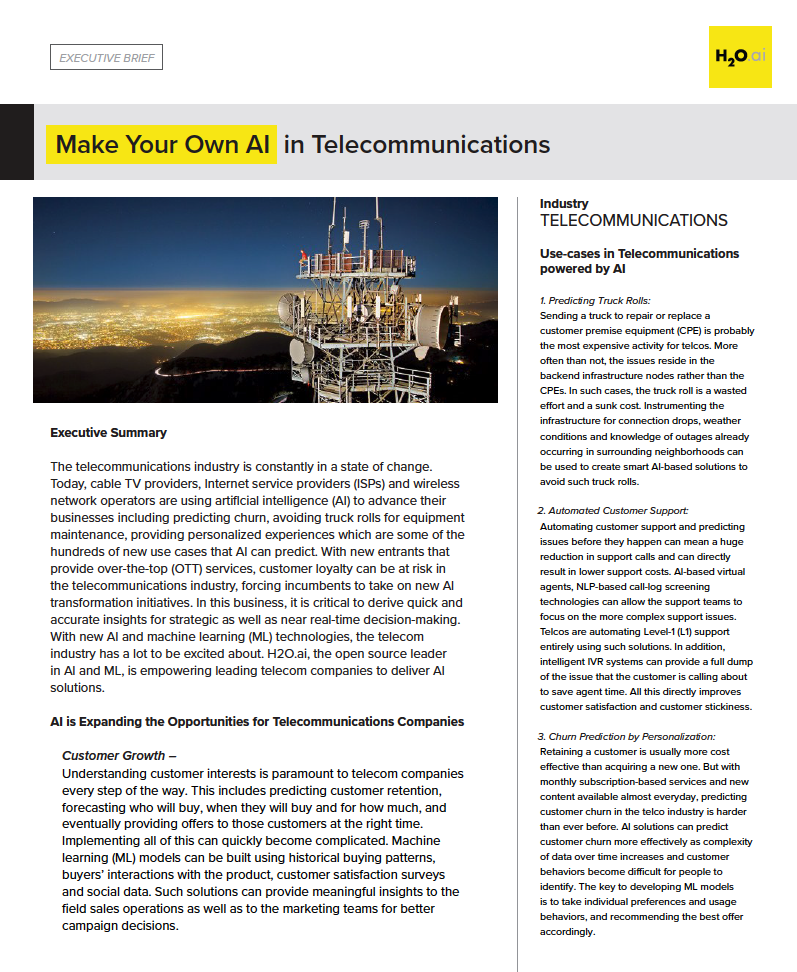Make Your Own AI for Telco
AI is Expanding the Opportunities for Retailers


Executive Summary
The telecommunications industry is constantly in a state of change. Today, cable TV providers, Internet service providers (ISPs) and wireless network operators are using artificial intelligence (AI) to advance their businesses including predicting churn, avoiding truck rolls for equipment maintenance, providing personalized experiences which are some of the hundreds of new use cases that AI can predict. With new entrants that provide over-the-top (OTT) services, customer loyalty can be at risk in the telecommunications industry, forcing incumbents to take on new AI transformation initiatives. In this business, it is critical to derive quick and accurate insights for strategic as well as near real-time decision-making. With new AI and machine learning (ML) technologies, the telecom industry has a lot to be excited about. H2O.ai, the open source leader in AI and ML, is empowering leading telecom companies to deliver AI solutions.


AI is Expanding the Opportunities for Telecommunications Companies
Customer Growth –
Understanding customer interests is paramount to telecom companies every step of the way. This includes predicting customer retention, forecasting who will buy, when they will buy and for how much, and eventually providing offers to those customers at the right time. Implementing all of this can quickly become complicated. Machine learning (ML) models can be built using historical buying patterns, buyers’ interactions with the product, customer satisfaction surveys and social data. Such solutions can provide meaningful insights to the field sales operations as well as to the marketing teams for better campaign decisions.
Operational Excellence –
Improving their own day-to-day operations is as important for telecommunication companies as is improving customer experience. Augmenting existing customer support teams with intelligent virtual assistants, automation of tedious processes, and quick turn-around-time (TAT) for issues found in the field are important business imperatives. Sales excellence to ensure that the sales teams are spending time with the right prospects is another example where AI is being used effectively.
Product Development –
Developing the next most awaited bundle of cable TV, Internet and phone services for expanding in the existing markets, as well as penetrating in the newer markets requires in-depth analysis of customer sentiment and feedback in those areas. Distilling information from social media channels, online customer feedback and interactive voice response (IVR) is important to make the right business decisions. Natural language processing (NLP) becomes a key technology ingredient in the development of such new products and services.

Use-cases in Telecommunications powered by AI
Why H2O.ai for Telecommunications – AI to do AI
H2O.ai offers an award-winning automatic machine learning platform in Driverless AI and has been recognized as an industry leader in the Forrester New WaveTM: Automation-Focused Machine Learning Solutions, Q2 2019. H2O, open source, is already being used by hundreds of thousands of data scientists and is deployed at over 18,000 organizations across nearly every industry.
H2O Driverless AI empowers data scientists, data engineers, mathematicians, statisticians and domain scientists to work on projects faster and more efficiently by using automation to accomplish tasks that can take months and can now be reduced to hours or minutes by delivering automatic feature engineering, model validation, model tuning, model selection and deployment, machine learning interpretability, time-series, NLP, automatic pipeline generation for model scoring and automatic documentation with reason codes, and now bring your own recipes and model operations and administration.
The new innovations and capabilities will enable customers to accelerate their AI transformations in the Telecommunications industry.
1. Predicting Truck Rolls:
Sending a truck to repair or replace a customer premise equipment (CPE) is probably the most expensive activity for telcos. More often than not, the issues reside in the backend infrastructure nodes rather than the CPEs. In such cases, the truck roll is a wasted effort and a sunk cost. Instrumenting the infrastructure for connection drops, weather conditions and knowledge of outages already occurring in surrounding neighborhoods can be used to create smart AI-based solutions to avoid such truck rolls.
2. Automated Customer Support:
Automating customer support and predicting issues before they happen can mean a huge reduction in support calls and can directly result in lower support costs. AI-based virtual agents, NLP-based call-log screening technologies can allow the support teams to focus on the more complex support issues. Telcos are automating Level-1 (L1) support entirely using such solutions. In addition, intelligent IVR systems can provide a full dump of the issue that the customer is calling about to save agent time. All this directly improves customer satisfaction and customer stickiness.
3. Churn Prediction by Personalization:
Retaining a customer is usually more cost effective than acquiring a new one. But with monthly subscription-based services and new content available almost everyday, predicting customer churn in the telco industry is harder than ever before. AI solutions can predict customer churn more effectively as complexity of data over time increases and customer behaviors become difficult for people to identify. The key to developing ML models is to take individual preferences and usage behaviors, and recommending the best offer accordingly.
Customer Case Studies
- Comcast, a leading telecommunications co
- A large telecommunications company based
Comcast delivers cable TV, Internet and phone services to millions of customers and operates the complete infrastructure across the U.S. When a customer calls for support and the agent cannot solve their problem, a technician is dispatched; in other words a truck roll is scheduled. Comcast constantly analyzes network issues and H2O Driverless AI helps to avoid truck rolls for issues that resides elsewhere in the network before a technician is sent. This improves customer satisfaction, and saves time and money for Comcast.
This US based telecommunications company has developed dozens of machine learning models using H2O Driverless AI and has deployed these in production across multiple teams. The use cases revolve around predicting subscriber and involuntary churn, fiber rollout, forecasting subscriber growth, predicting installments, call volume forecasting, and customer 360.
Win with AI – Get Started Today
AI is critical to success in the telecommunications industry. Driverless AI enables telecoms to accurately predict customer churn and truck rolls, automate customer support and increase the customers’ propensity to buy.